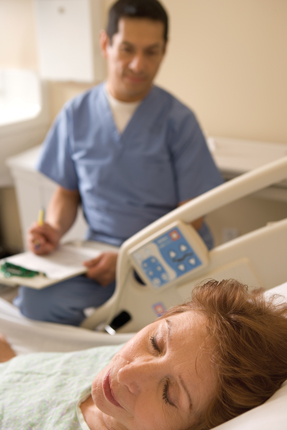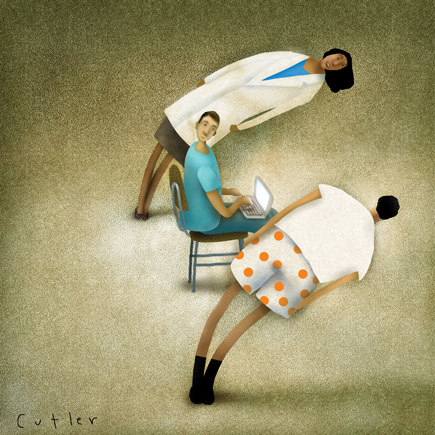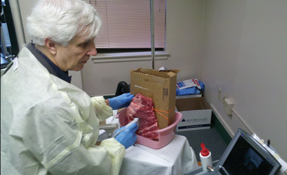Sleep disorders may be overlooked on exams
Experts want sleep habits considered as a vital sign. Sleep problems are important in themselves and can also have consequences on other major comorbidities such as mood disorders, diabetes and hypertension.
Sleep is one of our most basic human needs but it's rarely discussed during a typical primary care visit. However, according to the American Academy of Sleep Medicine, more than 70 million people in the U.S. have a sleep disorder, and the most common ones often co-exist with and can exacerbate other conditions seen frequently in primary care.
“In the sleep field, we hope that the surgeon general will recommend asking sleep questions as a vital sign. We think it's that important,” said James K. Wyatt, PhD, director of the Sleep Disorders Service and Research Center at Rush University Medical Center in Chicago. “Primary care physicians should know how to recognize the signs and symptoms of common disorders, which are very impactful for the patient but also extremely treatable.”

In a 2005 poll by the National Sleep Foundation, one-third of respondents were found to be at risk for insomnia, restless legs syndrome (RLS) and/or obstructive sleep apnea (OSA), with 2% at risk for all three. An estimated 26% of all Americans are at risk for OSA alone. The poll also found that people diagnosed with at least one other medical condition, including arthritis, depression, or heart disease, were more likely than others to be at risk for RLS, experience daytime sleepiness and have at least one symptom of insomnia, among other sleep complaints.
While experts suspect that many diagnoses are missed because primary care physicians do not screen for or ask about sleep problems, they acknowledge that internists are constrained by the typical 15-minute office visit. However, identifying a potential sleep disorder can be as simple as asking one or two questions, they said, and could lead to more effective control of co-existing conditions such as diabetes or hypertension.
“Just being aware is the first step,” said Robert D. Vorona, MD, medical director of the division of sleep medicine at Eastern Virginia Medical School in Norfolk, Va. “When you have [sleep] somewhere not too far in the back of your mind, you'll ask about it and, not infrequently, you'll be rewarded by finding out about something that can help you treat the patient.”
When, what to ask
Sleep complaints are common among primary care patients. One study that surveyed almost 2,000 adult patients in five family care practices found that more than half reported excessive daytime sleepiness, one-third had insomnia, more than one-quarter had symptoms of RLS, and between 13% and 33% reported symptoms of OSA. The study, published in the July/August 2007 Journal of the American Board of Family Medicine, noted that patients with hypertension, pain syndromes, and depression had a higher risk of sleep complaints than other patients, from two to four times the risk depending upon the condition and risk factors.
Physicians should routinely ask about sleep when treating patients at higher risk for sleep disorders, particularly those with associated comorbidities such as mood disorders, diabetes, hypertension or atrial fibrillation, said David Kuhlman, MD, medical director of sleep medicine at Bothwell Regional Health Center in Sedalia, Mo.
However, “You should ask about sleep especially if you're not having much success in controlling a patient's hypertension or mood disorder, etc., despite prescribing medication,” said Dr. Kuhlman. “By treating a patient's sleep apnea, for example, you may be able to better manage the atrial fibrillation.”
Physicians should also automatically screen for sleep disorders when patients present with obesity or a wide neck circumference, which are risk factors for OSA, said Dr. Wyatt. “They should think about sleep apnea with these patients just as they would automatically screen for diabetes in an obese person.”
A simple way to screen for sleep complaints is to include a sleep screening questionnaire on the new patient intake forms and existing patients' annual physical exam form, said Nancy A. Collop, MD, director of the Sleep Center at Emory University in Atlanta. For example, consider using a full or abbreviated standard screening questionnaire, such as the Pittsburgh Sleep Quality Index, to learn about general sleep quality, and the Berlin Questionnaire or the STOP questionnaire, which ask about symptoms related to OSA (see sidebar on page 15 for links).
Following up on symptoms
If patients respond positively on the initial screening, the internist should first try to establish what type of sleep problems they are having, said Clete A. Kushida, MD, PhD, medical director of Stanford University's Sleep Medicine Center in Redwood City, Calif. Are they sleepy during the day or do they have difficulty falling or staying asleep?
There are about 90 different types of sleep complaints, but potential diagnoses fall into six major categories, he said: insomnia, sleep-related breathing disorders such as OSA, sleep-related moving disorders such as RLS, hypersomnias, circadian rhythm disorders and parasomnias. Of those, insomnia, OSA and RLS are the most common.
If patients report experiencing daytime sleepiness, ask them about other symptoms of OSA, such as whether they snore or their sleeping partner has observed pauses in their breathing during the night, said Dr. Kushida, who is also president of the World Sleep Federation. If they complain about not being able to fall asleep, try to establish whether their poor sleep was triggered by an event (such as a divorce or other stressful situation) or if it is a longstanding problem that has frequently impacted their quality of life.
If OSA is suspected, the physician should also conduct a three-pronged physical exam, said Dr. Kuhlman. Suspect OSA if the patient has a large neck circumference (16 inches or greater for a woman; 17 inches for a man); a recessed chin, which makes it easier for the base of the tongue to fall back and close off the airway; or a low-hanging soft palette, which can be established by using the Friedman classification (a system that considers BMI, tonsil size and palate position) or by simply observing the thickness of the tissue in the throat using a tongue depressor.
Determining the underlying cause of insomnia is tricky because there are so many possibilities, said Dr. Vorona, co-author of ACP's PIER module on insomnia. To keep from “getting lost in the details” when questioning a patient, he recommended covering the following eight categories:
- Sleep environment. Is something in the environment, such as a poor mattress, making it harder to begin or maintain sleep?
- Sleep hygiene. Does the patient have a regular sleep and wake time? Is the bedroom reserved for sleeping? Does the patient use alcohol or caffeine?
- Medications. Is the patient taking one of a number of medications that could potentially impair sleep?
- Mood disorders. Has the patient been diagnosed with one or more?
- Intrinsic sleep disorders. About half of patients with OSA have complaints of insomnia, and RLS can cause insomnia.
- Medical disorders. Has the patient been diagnosed with other common medical disorders that could disrupt sleep, such as arthritis, chronic obstructive pulmonary disease (COPD) or gastroesophageal reflux disease?
- Circadian rhythm disorders. Has the brain's master clock shifted from the usual time of sleep/wake, for example, due to delayed sleep phase syndrome in a teenager?
- Psychological issues. Is the brain in a state of hyperarousal?
Drugs vs. behavioral therapy
Most sleep specialists recommend cognitive behavioral therapy (CBT) as the first line of treatment once an insomnia disorder has been diagnosed. However, sleep medications can be effective in certain situations or in combination with CBT, and some disorders can be effectively treated in the primary care setting.
For example, if a life event triggered the patient's insomnia, a mild sleeping pill might break the cycle, said Dr. Kushida. Similarly, if the patient suffers from depression or another mood disorder, prescribing medication for that condition first may alleviate the sleeping problem. Some disorders, such as RLS, respond to treatment with a dopamine agonist and can be managed effectively by the primary care physician, he added.
The latest generation of sleep medications, such as eszopiclone (Lunesta) and zolpidem (Ambien), has been criticized for triggering unusual behaviors, but these drugs are actually much safer than the older benzodiazepines if used correctly, said R. Robert Auger, MD, assistant professor of medicine and psychiatry at the Mayo Clinic's Center for Sleep Medicine in Rochester, Minn.
However, if the insomnia is chronic or OSA is suspected, it is best to refer the patient to a sleep specialist, who can devote more time to narrowing the diagnosis and mapping a course of treatment.
“The newer drugs are relatively devoid of problems associated with benzodiazepines, such as physical tolerance or withdrawal,” said Dr. Auger. “You can usually start and stop them without difficulty.” The key, he said, is to ensure that patients take the pill immediately before going to sleep as the onset of action is relatively quick.
However, Dr. Auger noted, the medications should be considered short-term therapy in most cases, used in times of stress or as the patient transitions through CBT. Typically, patients stop taking medications in four to six weeks, when behavioral therapies usually take hold, he said.
“Our ultimate goal is to reduce medication use for sleep,” said Dr. Collop. “We do use medications but our goal is to get them off medications if we can and use CBT to reteach people how to sleep.”
How to comanage
Patients suspected of having OSA should be referred for an overnight study in a sleep lab, either directly by the primary care physician or through a sleep specialist. In some cases, it makes more sense to refer to the specialist first to avoid duplicating efforts, said Dr. Kuhlman. (The American Academy of Sleep Medicine has a website that allows users to search geographically for AASM-accredited sleep centers.)
“If I get a patient referred directly by the primary care physician for a sleep study and the study is negative, what do we do then?” he said. “The patient has to see a sleep specialist anyway [to assess his initial symptoms], who orders another study.”
Home monitoring is another way to diagnose OSA and assess whether the patient should be treated with continuous positive airway pressure (CPAP). However, while it is favored as a first option by some insurers due to the lower cost compared with in-lab testing, experts said it should only be used for uncomplicated patients who are strongly suspected to have OSA but have no comorbidities that might require medical intervention during the study.
“There's always a tradeoff between cost and effectiveness,” said Dr. Auger. “One of the limitations [of home monitoring] is that you don't find out until the next day if there were technical problems, which may require repeating the study. Also, if OSA is identified, you are forced to prescribe an auto-titrating [positive airway pressure] device, which sometimes doesn't substitute for the human hands that can help adjust the pressure in the lab.”
Patients with comorbidities such as COPD, heart failure or morbid obesity are not suitable candidates for home monitoring because they may need medical attention during the study, noted Dr. Collop, who is president of the American Academy of Sleep Medicine. Even in patients with no co-existing conditions, home monitoring has several potential drawbacks, she added. For example, most home monitors measure only breathing, whereas a lab test measures brain waves during sleep. It's difficult to know whether a negative result from a home test is because of an inaccurate test or because the patient actually doesn't have OSA despite having symptoms.
Because of these potential downsides, some sleep centers are holding off on using home monitors until the technology becomes more reliable.
“We're not a fan of home monitoring yet,” said Dr. Wyatt at Rush Medical Center. “If someone is suspected of having OSA and has a positive home study, they would have to come to the lab anyway to try out CPAP. If they have a negative home monitoring test but were symptomatic in the first place, the route is to send them to a sleep center for a confirmatory lab study. In our sleep lab, we can make a diagnosis in the first two to four hours of the night and use the remainder of the night to titrate CPAP, so diagnosis and treatment are done in one study.”
While it is usually best for the patient to see a sleep specialist for conditions like OSA or chronic insomnia, the general internist plays a key coordinating role in comanaging patients with comorbidities, noted Dr. Wyatt.
“The best treatment is usually a parallel route. If obesity is a causal factor, the patient needs to go to a sleep center to quantify the degree of sleep-disordered breathing,” he said. “But along the way, the internist is in the best position to strategize about weight loss, which is the best long-term treatment.”
The “cross-tie” between specialists and primary care physicians is essential because sleep disorders can worsen other conditions, he added. For example, fragmented sleep can increase a patient's sensitivity to pain, so treating the sleep disorder may improve the patient's response to pain treatment or reduce the need for medication.
“The best care is coordinated,” said Dr. Wyatt. “With the transition toward patient-centered medical homes, the primary care physician is the hub of the wheel and the sleep specialist is one of the spokes. With great communication back and forth, we optimize treatment.”





